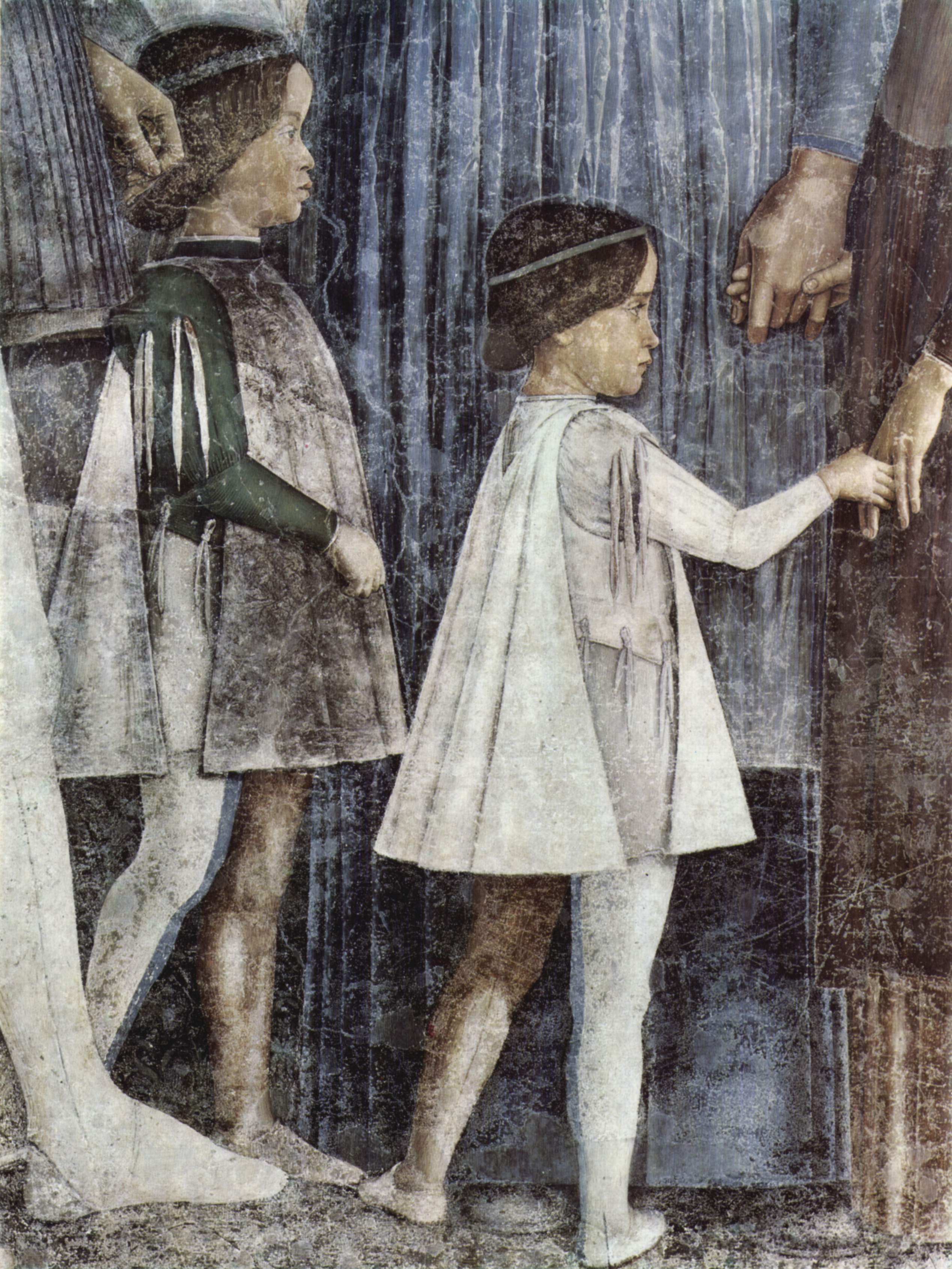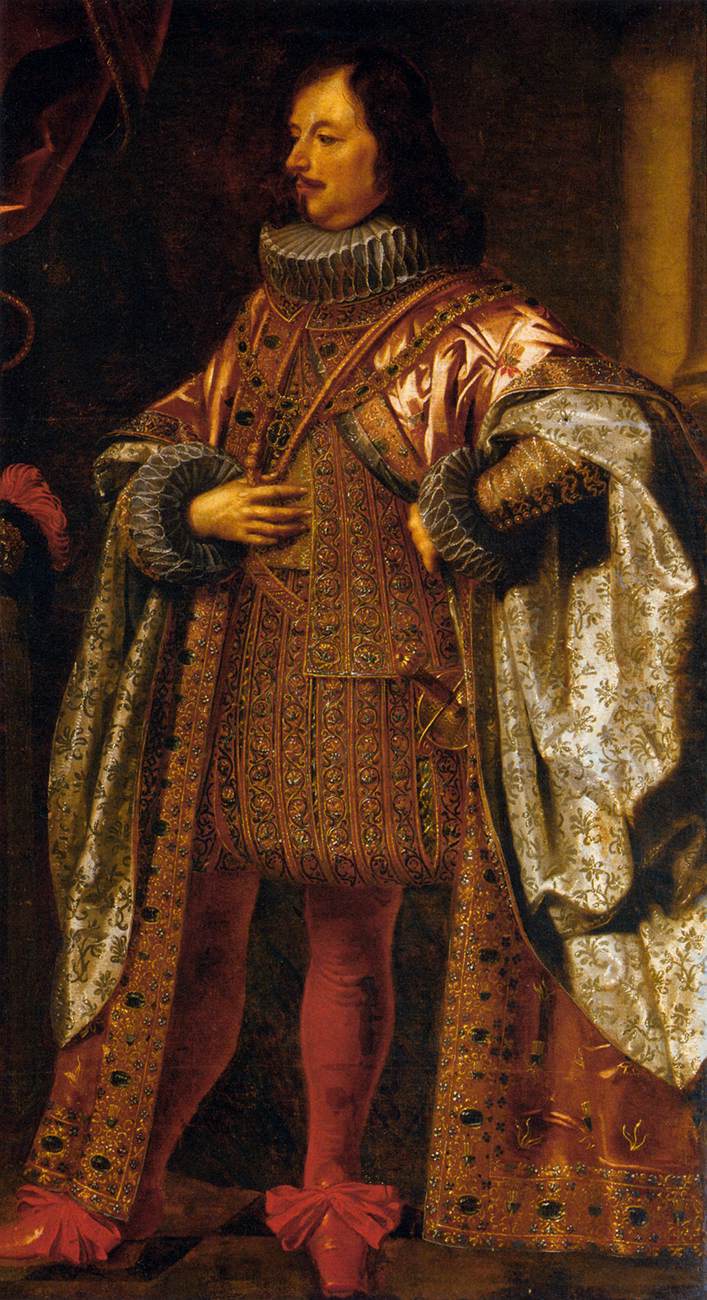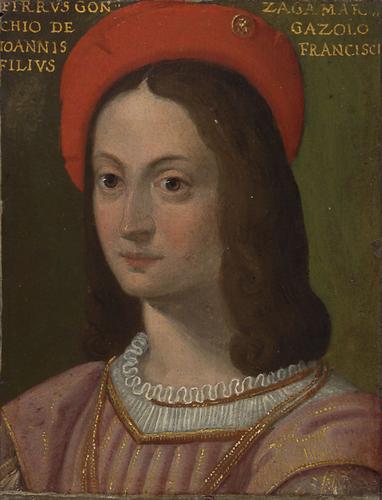|
Sigismondo Gonzaga
Sigismondo Gonzaga (1469, Mantua – 3 October 1525, Mantua) was an Italian cardinal. He was the third son of Federico I Gonzaga, Marquess of Mantua. Life He was the son of Frederick I of Mantua and commanded his brother Francesco II's troops before beginning his ecclesiastical career. He became apostolic protonotary. Pope Julius II was made a cardinal in the consistory of 1 December 1505. He was made apostolic administrator of Mantua from 1511 to 1521, finally resigning the post in favour of his nephew Ercole. He gained much sympathy from the schismatic cardinals but remained faithful to Julius II. He became apostolic legate to Bologna in 1511 and 1512 and legate to the March of Ancona and Mantua. He took part in the 1513 conclave which elected pope Leo X, that of 1521-22 that elected pope Hadrian VI and that of 1523 that elected pope Clement VII. He ended his career as administrator of Aversa at the start of 1524. He was the great-uncle of cardinals Francesco Gonzaga (1561 ... [...More Info...] [...Related Items...] OR: [Wikipedia] [Google] [Baidu] |
His Eminence
His Eminence (abbreviation H.Em. or H.E. or HE) is a style (manner of address), style of reference for high nobility, still in use in various religious contexts. Catholicism The style remains in use as the official style or standard form of address in reference to a cardinal (Catholicism), cardinal of the Catholic Church, reflecting his status as a Prince of the Church. A longer, and more formal, title is "His (or Your when addressing the cardinal directly) Most Reverend Eminence". Patriarchs of Eastern Catholic Churches who are also cardinals may be addressed as "His Eminence" or by the style particular to Catholic patriarchs, His Beatitude. When the Grand master (order), Grand Master of the Sovereign Military Order of Malta, the head of state of their sovereign territorial state comprising the island of Malta until 1797, who had already been made a Reichsfürst (i.e., prince of the Holy Roman Empire) in 1607, became (in terms of honorary order of precedence, not in the act ... [...More Info...] [...Related Items...] OR: [Wikipedia] [Google] [Baidu] |
Pope Hadrian VI
Pope Adrian VI ( la, Hadrianus VI; it, Adriano VI; nl, Adrianus/Adriaan VI), born Adriaan Florensz Boeyens (2 March 1459 – 14 September 1523), was head of the Catholic Church and ruler of the Papal States from 9 January 1522 until his death on 14 September 1523. The only Dutchman to become pope, he was the last non-Italian pope until the Polish John Paul II 455 years later. Born in the Episcopal principality of Utrecht, Adrian studied at the University of Leuven in the Low Countries, where he rose to the position of professor of theology, also serving as its rector (the equivalent of president or vice-chancellor). In 1507, he became the tutor of the future Holy Roman Emperor Charles V, who later trusted him as both his emissary and his regent. In 1516, Charles, now King of Castile and Aragon, appointed Adrian bishop of Tortosa, Spain, and soon thereafter Grand Inquisitor of the kingdoms of Aragon and Castile. Pope Leo X made him a cardinal in 1517 and after Leo's dea ... [...More Info...] [...Related Items...] OR: [Wikipedia] [Google] [Baidu] |
16th-century Italian Cardinals
The 16th century begins with the Julian year 1501 ( MDI) and ends with either the Julian or the Gregorian year 1600 ( MDC) (depending on the reckoning used; the Gregorian calendar introduced a lapse of 10 days in October 1582). The 16th century is regarded by historians as the century which saw the rise of Western civilization and the Islamic gunpowder empires. The Renaissance in Italy and Europe saw the emergence of important artists, authors and scientists, and led to the foundation of important subjects which include accounting and political science. Copernicus proposed the heliocentric universe, which was met with strong resistance, and Tycho Brahe refuted the theory of celestial spheres through observational measurement of the 1572 appearance of a Milky Way supernova. These events directly challenged the long-held notion of an immutable universe supported by Ptolemy and Aristotle, and led to major revolutions in astronomy and science. Galileo Galilei became a champion o ... [...More Info...] [...Related Items...] OR: [Wikipedia] [Google] [Baidu] |
1525 Deaths
Fifteen or 15 may refer to: *15 (number), the natural number following 14 and preceding 16 *one of the years 15 BC, AD 15, 1915, 2015 Music *Fifteen (band), a punk rock band Albums * ''15'' (Buckcherry album), 2005 * ''15'' (Ani Lorak album), 2007 * ''15'' (Phatfish album), 2008 * ''15'' (mixtape), a 2018 mixtape by Bhad Bhabie * ''Fifteen'' (Green River Ordinance album), 2016 * ''Fifteen'' (The Wailin' Jennys album), 2017 * ''Fifteen'', a 2012 album by Colin James Songs * "Fifteen" (song), a 2008 song by Taylor Swift *"Fifteen", a song by Harry Belafonte from the album '' Love Is a Gentle Thing'' *"15", a song by Rilo Kiley from the album ''Under the Blacklight'' *"15", a song by Marilyn Manson from the album ''The High End of Low'' *"The 15th", a 1979 song by Wire Other uses *Fifteen, Ohio, a community in the United States * ''15'' (film), a 2003 Singaporean film * ''Fifteen'' (TV series), international release name of ''Hillside'', a Canadian-American teen drama * ... [...More Info...] [...Related Items...] OR: [Wikipedia] [Google] [Baidu] |
1469 Births
Year 1469 ( MCDLXIX) was a common year starting on Sunday (link will display the full calendar) of the Julian calendar. Events January–December * February 4 – Battle of Qarabagh: Uzun Hasan decisively defeats the Timurids of Abu Sa'id Mirza. * July 24 – Battle of Edgcote: Yorkists are defeated and, in the aftermath, King Edward IV of England is taken prisoner. * August–October – Caister Castle in England is besieged by John de Mowbray, 4th Duke of Norfolk. * October 19 – Ferdinand II of Aragon marries Isabella I of Castile in Valladolid, bringing about a dynastic union. Date unknown * Sigismund of Austria sells Upper-Elsass (Alsace) to Charles the Bold, in exchange for aid in a war against the Swiss. * Moctezuma I, Aztec ruler of Tenochtitlan, dies and is succeeded by Axayacatl. * Anglo-Hanseatic War breaks out. * Marsilio Ficino completes his translation of the collected works of Plato, writes ''Commentary on Plato's Symposium on Love'', ... [...More Info...] [...Related Items...] OR: [Wikipedia] [Google] [Baidu] |
Vincenzo Gonzaga (cardinal)
Vincenzo II Gonzaga (7 January 1594 – 25 December 1627) was Duke of Mantua and Duke of Montferrat from 1626 until his death. Vincenzo was the son of Duke Vincent I and Eleonora de' Medici and inherited the duchy upon the death of his elder brother Ferdinand, receiving the imperial investiture on 8 February 1627. He had also received a cardinalate upon Ferdinando's succession, but had dismissed it in 1616 in order to marry his relative Isabella Gonzaga, daughter of Alfonso Gonzaga, Count of Novellara. Conscious of his poor health, the childless Vincenzo set up an inheritance for his lands through the marriage of his niece Maria (daughter of the former Duke Francis IV) with Charles of Nevers' son Charles of Gonzaga-Nevers. The elder Charles was a cousin of his father. Vincenzo died on the marriage day of Mary and Charles. Family Vincenzo II Gonzaga had no legitimate offspring from the wife, but he recognized four natural sons. By Paola Scarpelli: * Federico Gonzaga (1619� ... [...More Info...] [...Related Items...] OR: [Wikipedia] [Google] [Baidu] |
Ferdinando Gonzaga
Ferrante I Gonzaga (also Ferdinando I Gonzaga; 28 January 1507 – 15 November 1557) was an Italian condottiero, a member of the House of Gonzaga and the founder of the branch of the Gonzaga of Guastalla. Biography He was born in Mantua, the third son of Francesco II Gonzaga and Isabella d'Este. At the age of sixteen he was sent to the court of Spain as a page to the future emperor Charles V, to whom Ferrante remained faithful for his whole life. In 1527 he took part in the Sack of Rome and attended Charles' triumphant coronation at Bologna in 1530: at the death of Charles of Bourbon (1527) he was appointed commander-in-chief of the Imperial army in Italy. He became a Knight in the Order of the Golden Fleece in 1531. He defended Naples from the assault of the French troops under Odet of Foix, Viscount of Lautrec, and obtained the surrender of the Republic of Florence. For this feat Pope Clement VII, a member of the Medici who had been ousted from that city, named him papal g ... [...More Info...] [...Related Items...] OR: [Wikipedia] [Google] [Baidu] |
Scipione Gonzaga
Scipione Gonzaga (1542 – 1593) was an Italian cardinal, chiefly remembered for his friendship and patronage of the troubled poet Torquato Tasso and his support, against other family members, for his cousin Saint Aloysius Gonzaga. Life Born on 11 November 1542 in San Martino dall'Argine (or in Mantua according to other sources), he belonged to the family of the Dukes of Sabbioneta, his father Carlo being the Marquess of Gazzuolo. Second-born, he was destinated since his childhood to the ecclesiastic life. He passed his youth under the care of Cardinal Ercole Gonzaga, and made rapid progress in Greek and Latin studies. At Bologna, and later at Padua, he studied mathematics and philosophy, and, in the latter city, founded the ''Accademia degli Eterei'', or Academy of the Ethereals. Throughout his life he patronized literature and men of letters, among the latter being Tasso, who sought his advice concerning his ''Gerusalemme Liberata'', and Guarini, who dedicated to him his ''Il pa ... [...More Info...] [...Related Items...] OR: [Wikipedia] [Google] [Baidu] |
Pirro Gonzaga
Pirro Gonzaga (1490 - 22 January 1529) was an Italian nobleman and condottiero during the Italian Wars of 1494–1559. He was accused of treason against the Holy Roman Empire, sided with France, and was eventually defeated and imprisoned in Lombardy. History Pirro Gonzaga was the second child of Gianfrancesco Gonzaga (1446-1496), Gianfrancesco Gonzaga and Antonia Del Balzo. In 1499, after his father's death, he shared the inheritance of Sabbioneta, Dosolo, Pomponesco, Gazzuolo and Rodigo with his brother Ludovico Gonzaga (1480-1540), Ludovico. In 1521 he sold the area of Sabbioneta to Ludovico. In 1522 he participated in the conquest of Perugia. Taken as prisoner and accused of treason, in 1523 he lost his fiefs, which were assigned by the emperor Charles V, Holy Roman Emperor, Charles V to his nephew Louis Gonzaga (Rodomonte), Luigi Gonzaga. In 1524 he was defeated at the siege of Pavia. He later abandoned the imperial allegiance and sided with the Kingdom of France, French ... [...More Info...] [...Related Items...] OR: [Wikipedia] [Google] [Baidu] |
Francesco Gonzaga The Elder
Francesco, the Italian (and original) version of the personal name "Francis", is the most common given name among males in Italy. Notable persons with that name include: People with the given name Francesco * Francesco I (other), several people * Francesco Barbaro (other), several people * Francesco Bernardi (other), several people *Francesco di Giorgio Martini (1439-1501), Italian architect, engineer and painter * Francesco Berni (1497–1536), Italian writer * Francesco Canova da Milano (1497–1543), Italian lutenist and composer * Francesco Primaticcio (1504–1570), Italian painter, architect, and sculptor * Francesco Albani (1578–1660), Italian painter * Francesco Borromini (1599–1667), Swiss sculptor and architect * Francesco Cavalli (1602–1676), Italian composer * Francesco Maria Grimaldi (1618–1663), Italian mathematician and physicist * Francesco Bianchini (1662–1729), Italian philosopher and scientist * Francesco Galli Bibiena (1659 ... [...More Info...] [...Related Items...] OR: [Wikipedia] [Google] [Baidu] |
Giovanni Vincenzo Gonzaga
Giovanni Vincenzo Gonzaga (1540–1591) was an Italians, Italian Catholic Church, Roman Catholic Cardinal (Catholicism), cardinal. Biography A member of the House of Gonzaga, Giovanni Vincenzo Gonzaga was born in Palermo on December 8, 1540, the son of Ferrante Gonzaga and his wife Isabella di Capua. He was the younger brother of Cardinal Francesco Gonzaga (1538-1566), Francesco Gonzaga and the nephew of Cardinal Ercole Gonzaga. As a young man, his kinsman Guglielmo Gonzaga, Duke of Mantua called him to Mantua to assist him in the government of the Duchy of Mantua. There, he became a member of the Knights Hospitaller. He was also made Prior of Barletta. Pope Gregory XIII made him a cardinal deacon in the Papal consistory, consistory of February 21, 1578. He received the Galero, red hat and the Titular church#Cardinal-deaconries, deaconry of San Giorgio in Velabro on November 21, 1578. On December 19, 1583, he opted for the deaconry of Santa Maria in Cosmedin. He participa ... [...More Info...] [...Related Items...] OR: [Wikipedia] [Google] [Baidu] |
Francesco II Gonzaga
Francesco II (or IV) Gonzaga (10 August 1466 – ) was the ruler of the Italian city of Mantua from 1484 until his death. Biography Francesco was born in Mantua, the son of Marquess Federico I Gonzaga. Francesco had a career as a condottiero acting as Venice's commander from 1489 to 1498. He was the commander-in-chief of the army of the Italian league in the battle of Fornovo, under the tutorage of his more experienced uncle Ridolfo Gonzaga: even though Francesco was unable to stop Charles VIII and his army from returning to France, he claimed Fornovo as a victory. Francesco was described as "short, pop-eyed, snub-nosed and exceptionally brave, and was regarded as the finest knight in Italy". Francesco briefly commanded the Venetian army, but in 1502 he left to pay his respects to Louis XII who was then at Milan. By 29 April, he was with Louis XII when Genoa fell to the French army. Francesco, taking the initiative after the French victory at Agnadello, was occupying lands tha ... [...More Info...] [...Related Items...] OR: [Wikipedia] [Google] [Baidu] |




.jpg)
